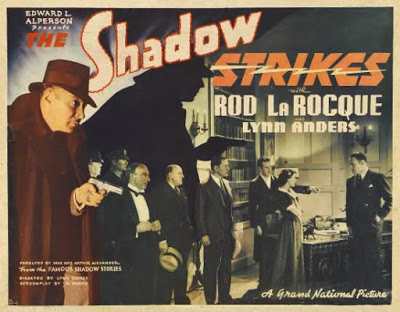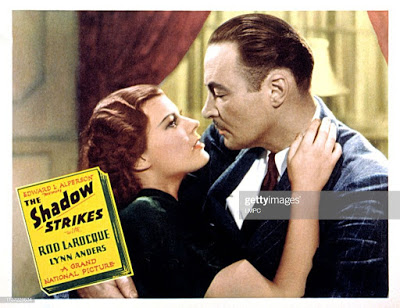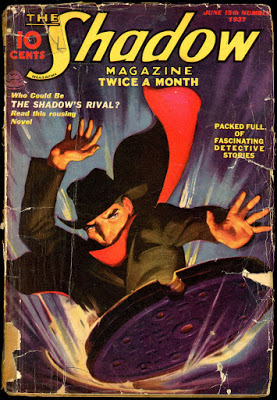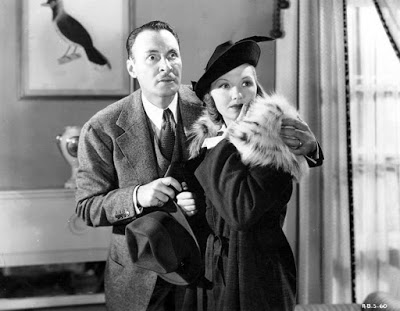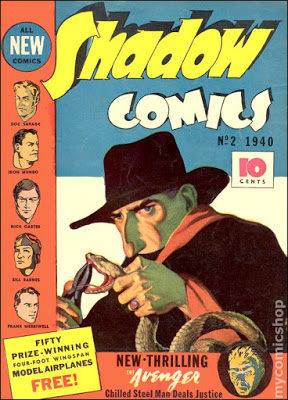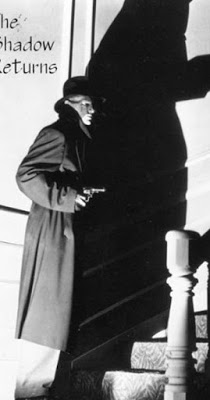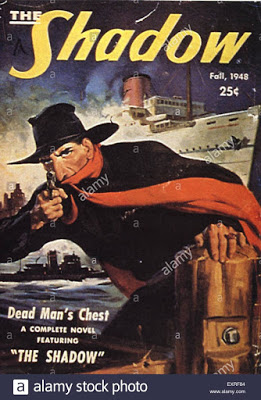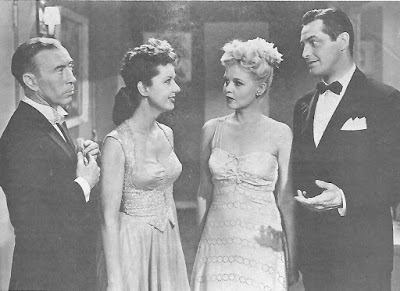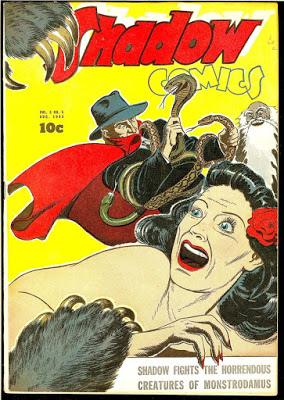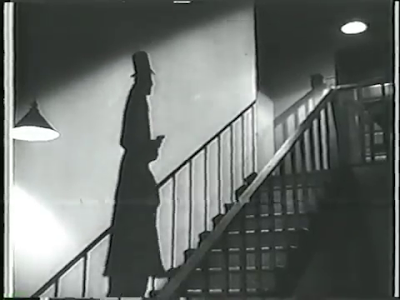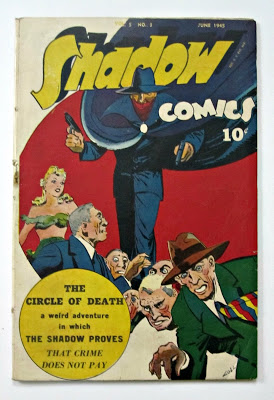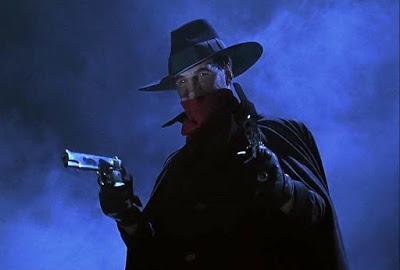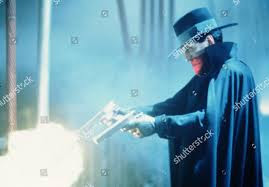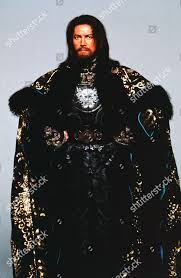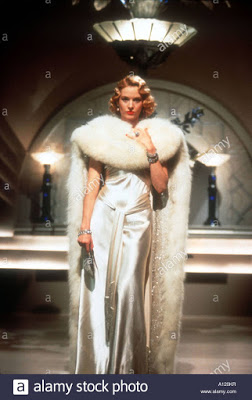The Shadow Knows What Evil
Lurks in the Hearts of Men
The Shadow Strikes (1937) - 4/10
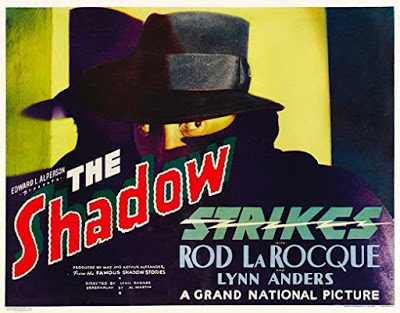
When I was growing up there would be occasions when my mother would go "Who
knows what evil lurks in the hearts of men. The Shadow knows". I guess that
was her way of telling me that she knew every bad thing I was up to. It wasn't
until years later that I realized it was part of an old time radio show.
The history of The Shadow is as convoluted as strands of DNA. It was part
of the pulp history of America back when pulp was really pulp. It was a magazine,
a radio show (in which at one point Orson Welles participated as Lamont Cranston),
loads of books and comics and comic strips and movies and TV shows. Marvel
marketing has nothing on those guys. But in all of these versions the storylines
were not necessarily connected - they often went off on narratives of their
own.
As best as I can tell The Shadow began as short stories in a detective magazine,
then they thought it would make a good radio show and then they asked for
books to come out and Walter Gibson was knocking out two books a month (some
are on Amazon). Of course movies came along and then TV. The Shadow was initially
the narrator on the radio show - similar to the narrator in The Whistler
movies. Later he became a crime fighter with some mild super powers who stole
the identity of Lamont Cranston - though there was a real Cranston - but
later on the idea that he wasn't really Cranston but only took his identity
(and others too) was dropped and The Shadow and Cranston became the same.
I think. His powers seem to differ depending on what source you are referring
to.
Now we come to this dime effort by a Poverty Row film studio called Grand
National who give him zero powers other than quick thinking and a certain
amount of charm. He only shows up twice as The Shadow and doesn't do much
other than hold a gun on people and call the police - ooh - the power of
calling the cops. He is played by one of my favorite names in films - Rod
La Rocque - who looks to be in his fifties here but was only in his late
thirties and near the end of his career. He had been a big deal in the silent
era working with DeMille on a number of films and also marrying one of the
more exotic foreign actresses in the business, Vilma Bánky who had
paired off with Valentino a few times. Unusually, they stayed married till
they both died a few months apart in 1969.
The film is a bit of a drag. The Shadow and in this case Lamont Cranston
has a bit of Batman in him. The English butler, a secret identity (he wears
a cape and a low brimmed hat to hide his face) and a murdered father that
he wants to revenge (of course, Batman wasn't created until two years later
in 1939). He is after proof on a gangster (Cy Kendall) when he is forced
by circumstances to take on the identity of a lawyer - whose office he has
broken into. This leads him into a murder mystery among a wealthy family
and The Shadow pretty much disappears from the film until the very end. Why
make a film about The Shadow and then barely feature him in that identity?
Only The Shadow Knows.
International Crime - (1938) - 5/10
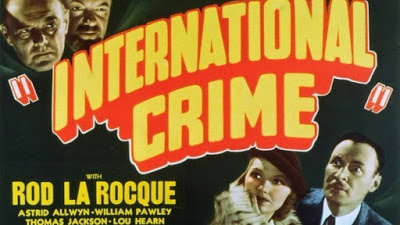
A year later Grand National Pictures is back with their second and last film
of The Shadow again starring Rod La Rocque. It is actually a much better
film on most counts - some humor, a decent mystery, La Rocque is quite personal,
they add a pretty female assistant but in this one The Shadow never appears!
Just the strangest damn thing. By this time The Shadow had been around in
radio, book and comic form for nearly a decade in which this secret fighter
for justice in his hat and cape were very well known - in the first film
he makes two brief appearances - but not here. There must have been a reason
but I have no idea what it was. perhaps this being a B (or maybe even C)
film the hat and cape would have put them over the budget!
Lamont Cranston (La Rocque) has a radio show called The Shadow in which he
reports crimes committed, tells people to be on the lookout for certain things
like a license plate number, tells his audience that a criminal has been
released from prison, tells them that crime doesn't pay and he also gets
involved in solving crimes. A female assistant (Astrid Allwyn) named Phoebe
Lane is forced upon him and of course she gets in his way constantly - in
the books and radio The Shadow is helped by a character named Margo Lane
(interestingly, the first Superman comic book came out this same year - Lois
Lane?).
Now everybody knows that Cranston is The Shadow - how - because he tells
them on the radio. I am officially confused. Anyway, Cranston gets involved
in a murder case that seems to be pointing at foreign agents who have Austrian
accents. In one silly scene Cranston pretends to be Austrian and imitates
an Austrian accent while talking to two Austrians who conveniently also speak
English in an Austrian accent. It comes in at a neat 65 minutes and is light
and quick and entertaining a notch above a kick in the shins.
The Shadow Returns (1946) - 5.5/10
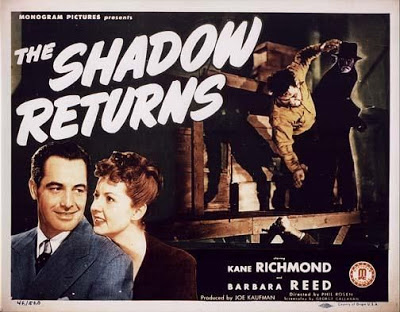
After Grand National produced two films featuring The Shadow (sort of) they
dropped it. In 1940 Columbia picked up the character for a 15-part serial
starring Victor Jory. The serial is what the Shadow is supposed to be about
- an arch enemy who appears as a beam of light, the Shadow in cloak, mask
and wide-brimmed hat able to switch identities at a moment's notice. Cheap
as most serials were but imaginative. Then in 1946 the King of the Poverty
Row studios, Monogram, produced three films with The Shadow starring Kane
Richmond who seems to have spent his entire career in B films.
This one isn't as nifty as the serial but it is a big step above the two
films from Grand National. For one thing Lamont Cranston as The Shadow appears
constantly through the film jumping into and out of his Shadow outfit like
a jack rabbit. The film also has the dependable comic relief in the form
of his rough none too bright driver and sidekick (Tom Dugan) and romance
in the form of his girl Friday Margo Lane (Barbara Read, who appears in all
three of The Shadow films). It just makes the one hour mark and crams in
a few murders, a few kisses, a bunch of suspects and one good fight.
Here Cranston is the nephew of the police commissioner and this enables him
to pretend to be an amateur criminologist who hangs about as he seems to
be independently wealthy. When a grave is dug up and jewels are uncovered
by the police it leads back to a house where a group of people are waiting
for them - but the jewels have vanished. Soon the deaths begin and Cranston,
his two assistants and his alter ego begin an investigation that is more
than a bit confusing. This leads to some chemical mumbo jumbo that makes
no sense at all. But does it really matter? It is directed by B director
stalwart, Phil Rosen, who had over 140 credits to his name and could bring
home the bacon on time and on budget - he directed a bunch of the Charlie
Chan films.
Behind the Mask (1946) - 3.5/10
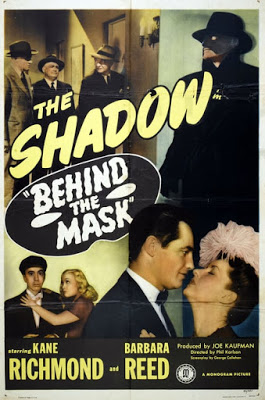
This is the second Monogram film of 1946 featuring The Shadow and everything
they did right in the first one is left out of this one. They decide to turn
it into a comedy romp with a bit of mystery occasionally interrupting the
hoped for laughs. It is really quite bad which is a bit surprising since
it is directed by Phil Karlson who has some solid credits in the crime genre
- Kansas City Confidential, 99 River Street and the Phenix City Story - but
is also admittedly responsible for two of those dreadful Matt Helm films
starring Dean Martin - The Silencers and the Wrecking Crew. All of these
were in the future after Behind the Mask. There is only so much you can do
with a bad script and no budget.
Lamont Cranston (Kane Richmond again) is about to marry his girl Margo Lane
(Barbara Read), who has made him promise to stow the hat, mask and cape of
The Shadow away in the moth balls. His comic relief assistant is played by
George Chandler and they give him a girlfriend too played by Dorothea Kent.
Neither woman wants their man to take any chances and way too much of the
film is taken up by squabbling between the couples and the women tagging
after the men to make sure they stay out of trouble and don't get cute with
any other women. It gets really old, really fast.
A gossip journalist who does some blackmailing on the side is raising his
prices and that leads to his inevitable murder. By someone wearing The Shadow
garb. So the real Shadow has to look into it - one suspect runs a nightclub
where he sets up married men in a compromising position and takes a photo;
another has a betting parlor where bets are made through a juke box. Along
with the comedy is one of the more irritating music tracks ever. To be fair
the video up on YouTube is a little murky and the sound is about 10 seconds
behind the film. So you will see someone moving their mouths and hear them
later - but I don't think it made that much of a difference.
The Missing Lady (1946) - 6/10
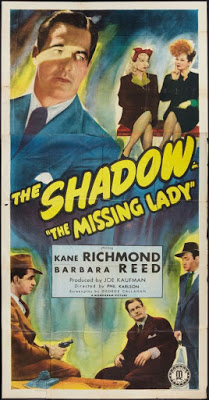
The whole crew is back In the third and final Monogram film of The Shadow.
Phil Karlson is the director with Kane Richmond as Lamont Cranston, Barbara
Read as his girl Margo Lane, George Chandler as Cranston's assistant Shrevvie
and Dorothea Kent as Shrevvie's girl friend. How often does the comic relief
get a girl friend too in these sorts of films. I thought that this would
be a replay of the second film that went all in on the comedy with these
two couples exchanging barbs of jealousy, but instead Karlson delivers a
fairly solid mystery with the comedy given a back seat. But again as in all
these Shadow films, the Shadow takes a back seat as well. There is one good
slug em up but it is Cranston doing the slugging, not his alter-ego The Shadow.
The first ten minutes of the film shows the promise that Karlson would bring
later into his crime films. It begins with a man at a desk being shot in
cold-blooded fashion and a statuette called The Jade Lady being stolen. The
scene then shifts to a down on its heels neighborhood populated with seedy
bars, women of the night and flop houses. An unseen train passes by throwing
flickering light on this noir like scene. A giant of a man whispers to another
that he will get back the Lady tonight. The other says you better. A hard
bitten blonde dame gives sass to two men who demand that she helps them -
one slamming a knife between her fingers to which she replies that's what
I love about you. The giant of a man called Ox walks up the stairs into a
flop house where weary men are doing their best to get some shut eye and
a fight breaks out with Ox getting the worst of it. The other man is Cranston
going under cover as a bum and he escapes but only to return as The Shadow
a few minutes later as a shadow ascends the stairs with no man visible -
just a shadow. For those few minutes this was a terrific film.
Then it falls back to the ordinary but still a solid crime film with a series
of murders, Cranston suspected of them, shouting cops, a couple good looking
women, a scramble for the Jade Lady and a finale of a room full of suspects
gathered together like Poirot would do. Not a lot of The Shadow though. The
so-called comedy comes in because Cranston keeps referring to the Jade Lady
as the Missing Lady leading the cops to think that a woman has been kidnapped
and the two girlfriends to think the their two boys are off looking for female
company. Kind of a cheap silly forced attempt at humor that just wasn't needed.
What was somewhat amusing were the two old biddies who ran the elevators
and raced each other - played by two veterans of the stage and vaudeville
- Almira Sessions and Nora Cecil who should be in every film of this kind.
The Shadow (1994) - 7.0
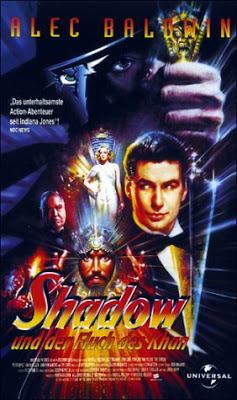
By the time this film came out in 1994 The Shadow was barely a blip on most
people's radar, a vague memory that they recalled they had heard about from
somewhere. The last films had been made 50 years previously, the comic strip
had ended in 1942, the radio show saw its last days in 1954 and The Shadow
Magazine shut its doors in 1949. One thing we have perhaps learned since
this film was released is that a super hero film is helped tremendously by
a built in fan base. This film had none. So I expect that when it was released
most people sort of went . . . The Shadow? I know that I did and that when
I saw it I was mainly confused - who is this guy that seems to be able to
make himself invisible at times. The film basically made its money back and
then ended up taking up space in video stores. I wonder if the success of
Dick Tracy from 1990 influenced them to make this film - also set in the
1930s with pulp and comic book origins but the comic strip was still appearing
in the papers at that time. The Phantom that came out two years later in
1996 did not fare so well - quite a bomb but who goes to see Billy Zane in
a film.
Seeing it again for the first time in 25 years it struck me that in some
ways that the film was ahead of its time with a super hero who was an inch
away from being a sociopath - as much The Joker as Batman. Troubled by nightmares
and his past misdeeds, he seems uncertain at times as he tries to turn his
karma around. As Lamont Cranston he lives a life of luxury seemingly wanting
for nothing and going through women with ease. But inside he is torn between
good and evil. His nemesis in this keeps pushing him towards his dark side
- that is who you are, that is what you want to be again. This all plays
out in the art deco dark world of New York City in the 1930s with sleek costumes,
cars and architectural designs.
Originally he was Ying Ko, a psychotic war lord and drug smuggler in Tibet
who is kidnapped by a Holy Man and over seven years turned to the good side
and let loose in NYC as The Shadow with Cranston as his other identity. Was
he Cranston before he became Ying Ko - hard to say since he has the ability
to cloud men's minds and so when the Police Commissioner calls him his nephew
is that real or a thought implanted in his head by Cranston. Upon seeing
this film with no background it might just seem silly - you have this hero
all covered up in a hat and cape hiding in the shadows with a maniacal laugh
and the villains all dressed up in Mongol costumes right out of the days
of Genghis Khan running around the streets of New York City - but the film
is really attempting to go back to the pulp roots of the comics and radio
show in which The Shadow was often waging battle against the forces of evil
from the Far East. For the most part it gets it right in its comic book mood
and look.
A new danger arrives in the city inside a metal casket that is delivered
to a museum - inside is an ancestor of Khan who has designs to take over
the world. Of course. Why settle for a nice penthouse apartment on 5th avenue
when you can have the world. As to why he was delivered in this manner as
opposed to just buying a plane ticket isn't clear because his Mongol horde
seems to have managed to get to NY in their outfits quite easily. He has
the ability to hypnotize as well having been trained in the same temple as
Cranston. He plans to build a bomb to blow up the city and only The Shadow
with the help of his crew (all people he has saved before and then gotten
them to promise to help him if need be) and a woman who can read his thoughts,
Margo Lane. It is all rather fun.
There is a terrific cast here. Alec Baldwin as Cranston of course but also
Peter Boyle as his always at the ready taxi driver (the taxi idea is from
the pulp novels), John Lone as the villain, Tim Curry in fruitcake mode as
an evil inventor, Jonathan Winters of all people as the Commissioner, Penelope
Ann Miller as Margo and Ian McKellan as the inventor father of Margo. All
of them overplaying their roles a bit as they should in a film like this.
I wonder whether there will ever be another Shadow film - as far as I know
it isn't owned by either DC or Marvel so probably not.
